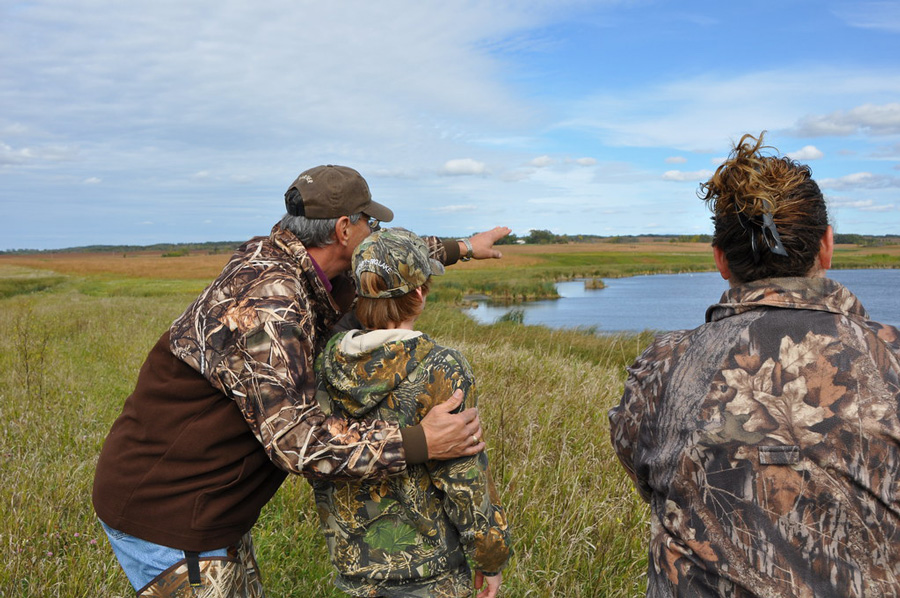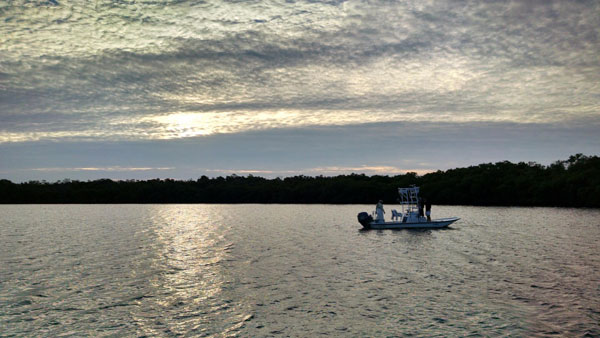The law that is broadly and affectionately known as PR ironically doesn’t allow state wildlife agencies to market hunting to a new generation of license buyers—the sportsmen and women we desperately need to keep funding conservation
By now, you probably know that every time you buy a hunting or fishing license and certain gear, you’re paying into a hugely successful system of conservation in America—where those of us who enjoy and take something from our natural resources also give back to fish and wildlife. You’re probably even aware of the two laws that made this happen: the Pittman-Robertson Act for hunting-related spending and the Dingell-Johnson Act for fishing-related spending.
[Need a refresher on all the biggest sources of federal conservation funding? We got you.]
But there’s a major difference between these policies that has become glaring as fishing participation has crept back up and hunting participation has taken a steep nosedive.

Between 2011 and 2016, the number of hunters declined by 16 percent. Hunters spend fewer days afield and less money on equipment on average than they used to. In that same time period, 2.7 million more Americans started fishing, and spending on fishing equipment increased by more than 36 percent.
This could be because about $12 million in funds created by the Dingell-Johnson Act annually go toward national efforts to recruit, retain, and reactivate (R3) anglers. Meanwhile, no such provision is made in Pittman-Robertson.
Besides the next generation of sportsmen and women, state wildlife agencies have the most to lose if hunting and fishing participation declines, because many of these conservation-focused departments depend entirely on P-R and D-J dollars. But, as the laws are written, even a state department of natural resources with an excellent apprentice hunter program can’t so much as print up a poster to advertise it using P-R funding.
The ability to communicate with and educate the public about hunting is so much more important today than it was in the 1930s when this bill was written. At that time, more than half the country hunted or had access to someone who could likely show them how. This just isn’t the case anymore.
The Bottom Line
It’s time to modernize Pittman-Robertson and allocate just a small portion of its funds to R3 activities—the return on investment is likely to be millions of more active and engaged outdoorspeople paying into a conservation model that supports some of America’s greatest traditions. Failing to do so could create a conservation funding crisis like we’ve never seen before.
Legislation called Modernizing the Pittman-Robertson Fund for Tomorrow’s Needs Act (H.R. 877) has been reintroduced this Congress and debated in a House Natural Resources Committee hearing earlier this year. After the August recess, we need to move this bill forward without delay and before we lose lawmakers’ attention to the chaos that comes with an election year.
Have you seen state agency efforts to attract and educate new hunters that deserve more of a PR spotlight? Tell us in the comments.







I agree with this post. The R3 effort for fishing is a powerful tool and should be applied to hunting. The average age of hunters continues to increase and we aren’t seeing enough young hunters being recruited. Without continued and increased revenue from hunting related purchases the N. American big game model fail. This will lead to a decrease on spending for habitat and the animals we all admire will pay the consequences.
In California, I believe hunting has declined due to the lack of available quality public land to hunt, as well as more private landowners closing their property to hunting. In addition, drawing an elk, pronghorn, or premium deer tag could take years, if ever. The odds of drawing the few random tags are so high I don’t even bother anymore. My kids will not likely ever draw one of these tags. The other thing is that the anti-hunters are becoming more and more successful in eliminating hunting. We can no longer pursue bears with dogs, hunt mountain lions, or trap bobcats. A total ban on bobcat hunting is in the works and I have no doubt it will pass. Now wolves are taking hold, and they, along with the increasing bear population, will start having an impact on the deer and elk populations. Once that happens, not even private land will produce quality deer herds, and there won’t be any tags available anyway. So, even if we tried to recruit new hunters, the best we can do is send them into public land areas that are overrun by hunters and severely lacking in animals. They get discouraged very quickly. The time and money it takes to scout backcountry areas with fewer hunters, as well as hunt them, is beyond that of most families. If dad takes two weeks of vacation to scout and hunt, that doesn’t leave much time for family vacations. I have hunted deer on public land in Utah for 30 years, and the situation there is much different. Not only do I consistently draw a tag, the animals are better managed and there are far fewer people in the field. California will continue to take actions that are detrimental to hunters. They are slowly working to remove hunting as a tool of wildlife management. Then there’s the war on guns. California has become a joke, with few laughing. No amount of R3 will help. I’m a native son and never thought I’d say this, but I’m moving out. The sooner the better.
You are correct. Example: all of my father’s grandsons hunt. Only four of my eight grandsons hunt. None of the five granddaughters hunt. Geography plays a role here, four different states and two countries. They are into many activities beyond sports and we now compete with the Internet for their attention and interest. Marketing and promoting hunting will ensure that the conservation efforts we have experienced will continue to benefit future generations. Best, John
This report is accurate. However, I worry that opening up PR and DJ for broader use in hunter recruitment will lead to agency administrators backing off from doing surveys, modeling, and research that are foundational to conservation. Anti science could undermine the science base. Also, expanded use of pen raised birds can threaten conservation of wild birds. Using the domestic to recruit hunters could create lower expectations.
I have not observed an Ohio effort to to encourage involvement of new hunters. But then, Ohio has removed most of its wetlands and forrest so it does not have much left.
All Americans, whether they hunt and/or fish should have a hand in funding the work of state fish and wildlife agencies. We are, after all, talking about Americans’ natural heritage. I think the Missouri model of funding is worth a hard look by all states. Dedicate a share of a state’s sales tax to conservation. We already pay, as a society, untold gillions in taxes whenever we go out and buy a new car. (And cars and their infrastructure are well known for their role in degrading/destroying/fragmenting wildlife habitat.
Had a great place to deer, rabbit, and duck hunt for over 30 years❤️ The farmer/ owner died and his kids sold the farm to a house developer 👹 From 300 Acer’s to sub lots👹
Second place l deer hunted 35 years farmer/ friend died, kids sold farm to three different people NO HUNTING!
Back in the 60 l started rabbit and quail hunting on old rail road tracks NO MORE👹 Not growing public land so much, every now and then the state picks up a small track of land, but very rare! Public place way over hunted, over harvested 😞
I think that allocating a percentage of the PR acts money to recruit new hunters and retain and return old hunters is an excellent idea. Serious thought and timely response is important!
I feel that since the same idea and efforts to increase fishermen using a percentage of the Dingall- Johnson funds has worked so well that a percentage which equals that amount of funds should probably be allocated for the same type of spending. Otherwise, we will continue losing hunters. This information needs to be proclaimed so that people are aware of the money that hunters spend will make the Image of hunting and Hunters better. in the public eye.
I think that the difference of a traditional, bolt action or lever action hunting rifle should be explained and clarified, differentiated from the assault weapon. That the act of harvesting wild game is not like industrial farming of our meat products is… That hunting conserves wildlife and ads to the preservation of game by financing winter feeding stations, and buys land for game to live and propagate on.
I defer to the eloquent content by Matthew Van Camp. As an avid hunter and conservationist, I have long campaigned for more education and opportunities the introduce women to hunting. These Dingall- Johnson funds are critical to educating women, who are key swing stakeholder is which family activities are financially supported, in the holistic family values that come from ethical hunting.
You already have my state government caught trying to divert PR moneys years ago and getting caught by the Feds.
Now NY spends PR money on a percentage of salaries for ECO every year. If this law is re-written it will need more protections against the money being misdirected.
I totally agree with that post
It is time for hunters and anglers to step up and contact our members of Congress to tell them we want to modernize the P/R act. I am glad to report that Kansas has an up and running R3 program.
R3 programs are just agencies chasing their tails. Instead of trying to convince young people to do something they’re not interested in, agencies should be working with the non-hunting public to find new ways to fund wildlife conservation that aren’t tied to hunting and fishing. Everyone has an interest in wildlife, and everyone should help pay for its conservation.
Well, hunting has been declining since the 1970s with a lot of ups and downs. The reasons are well known. If we wish to improve the PR ACT, the best thing we could do is encourage additional resources for funding. I like excise taxes on outdoor equipment such as backpacks, hiking shoes, binoculars and spotting scopes. There are a lot of folks out there who enjoy the wildlife resource that are not hunters. I certainly promote efforts to encourage more hunting opportunity and involve more people, but this has been going on for some time and the overall trend hasn’t changed. The focus most of the hunting community has is in trying to perpetuate and increase hunters, and the wildlife resource comes next. I would, as a person who first bought a hunting license in 1950 and has bought at least one every year since would like to see the hunting community take up the effort to see more kinds of funding for wildlife conservation. It would be in our interest to continue to take leadership by promoting additional funding sources. If we were to take a major leadership role in this effort, it would provide an argument about how the hunting community has traditionally been in the forefront of efforts to benefit wildlife and continues. That is the best defense of hunting that I know of.